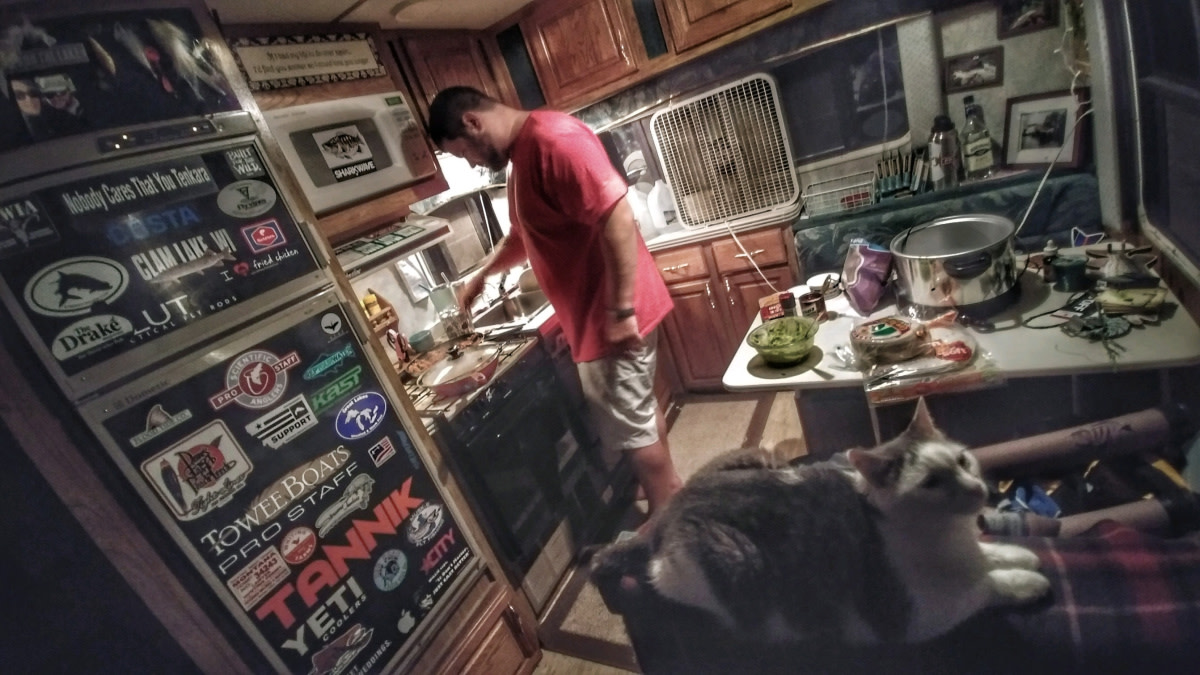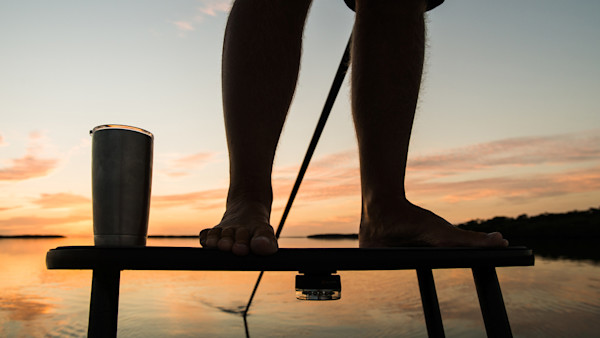
This is the second installment in a five-part series outlining the experiences of working fishing guides and what it takes to survive a dream job. If you missed part one, you can read that here.
It’s easy to assume that fishing guides make more money than they actually do. Multiplying an outfitter’s $500 per day rate by a vague estimate of “guidable days” each year can lead aspiring guides to imagine themselves getting rich by taking people fishing. In reality, few guides make a comfortable living. Most people who make their living in this profession prioritize quality of life over wealth.
Hilary Hutcheson, a guide and fly shop owner out of Columbia Falls, Montana, started guiding as a teenager and has spent the last 20 years figuring out which lifestyle best suits her and her family. “I’ve learned that if something is going to fall to shit, it’s going to fall to shit—and the more you have, the more you’ll lose. I continue to guide because what it lacks in financial security it makes up in spiritual security.”
Over the years, Hilary worked as a news anchor and reporter, but ultimately returned to the fishing industry despite its instability. “As a guide, money is always tight, but I don’t have the tightness in my chest that I felt when I left guiding for higher-paying careers.”
Hilary is a mother of two, but when she first started guiding she was young and single. Such independence is common among new guides—no dependents, modest income, obsessed with fishing and rarely home. It’s far easier for an untethered young person to embrace the nomadic and unstable life of a fishing guide than someone who has a family. Full-time guides often need to travel between fisheries, absent from home and family for lengthy periods of time.
Jordan Romney, a guide in Northern California, grappled with this dilemma. “Around my fifth year of guiding, I had some hang ups in dealing with the uncertainties of it.”
Jordan knew he wanted stability in his life and, ultimately, a family. He wondered if those goals were compatible with the guiding lifestyle. “I noticed the high majority of divorced guides and it scared me.”
He faced a conundrum familiar to most long-term fishing guides—give up the work they love and settle into the security and stability of a “real job,” or continue scratching out a living through the unpredictability and the stress on his home life. “I chose the latter, and part of that choice was deciding that I could never look back.”
Jordan and his wife find 200-225 days of guiding to be the right balance, but their schedule remains hectic. Jordan’s days start at 5 a.m. and finish at 6 p.m., leaving little time between shifts to do much beyond sleeping, packing lunches, tying flies and prepping for the next day. Last-minute bookings also strain family time. “The rug gets pulled out from camping trips and vacations to the beach with the family. But it’s nothing new, we have found ways to make it work. I wouldn’t be happy doing anything else.”
Forty-three-year-old guide Rob Kessler subscribes to the traveling guide lifestyle. He’s guided in Montana for 19 years where the fishing, and therefore the work, is seasonal. To make ends meet, he’s guided for the past nine years in Key West, Florida. The travel keeps him away from his wife for five months a year. “I always miss her and our dog, but when we’re together we aren’t living paycheque to paycheque, we’re able to take some nice (non-fishing) vacations.”
Rob is the exception. The vast majority of guides do live paycheque to paycheque. Brant Oswald, experienced guide and guide school instructor, has seen this firsthand. A protege of Mel Krieger, Brant started guiding in the 1980s and has witnessed the unraveling of many newcomers who expected the guiding game to be easy.
“They guide for a while, don’t get as many trips as they thought they would and find the winters can stretch a summer of guide income pretty thin—especially when they spent most of their tip money in the bar every night. For some of those guides, the actuality of the guide life can be a big disappointment, and they often burn out early.”
Lodges, shops and outfitters take a significant cut of daily guide fees (anywhere from 40 to 60 percent). That cut is justified—outfitters pay for marketing, credit card fees, pre-trip arrangements and other costly overhead—but many full-time guides work as independent contractors, leaving them responsible for trip and business expenses.
Jordan estimates his annual fuel cost at $9,000. “Now add [guide] licenses, insurances [liability and health], lunches, tackle, ice, drinks, etc. I like to say this is my get-rich-slow scheme. My wife and I joke that we are ‘hippy rich.’”
Though many guides appreciate the quality of their lifestyle, they still have bills to pay and mouths to feed. The average trout guide brings home around $40,000 a year, and while there are a select few who can make six-figure incomes, they’re exceptions within the industry or are guiding fisheries that charge a hefty daily rate.
Guides do make decent tips, and those tips can bolster low wages. An Alaskan guide working through the summer may earn less than $100 a day, equating to only $6 or $7 per hour, so tips help to carry them through the season. That said, not every culture believes in tipping and not every client shares their guide’s perspective on what constitutes a good or even reasonable tip, so it’s not exactly reliable income.
One final but important topic when considering the financial realities of guiding is retirement. Most of the guides I spoke with don’t have a long-term plan in mind—they don’t even want to think about it. Jordan Romney summed up many fishing guides’ perspective on retirement planning. “This is something I have pushed out of my mind and try to never think about. I really do not have a plan.”
Sean Blaine, a 50-year-old guide in Montana, is realistic about his future. “I have managed to put some savings away over the years, but in all honesty, it’s not going to be enough for retirement.”
Josh Zeigler, a young upstart guide, has no illusions about his future. “When I was like 17 and working in a fly shop, I asked the owner if there was a retirement plan for fishing guides. He turned and said one word: ‘death.’”
In all my digging and interviews, I didn’t find a single outfitter or lodge that currently offers retirement or health care benefits for guides.
While most guides earn blue-collar wages, lack healthcare and retirement benefits, and have no idea how much money they’ll make in a given year, they are quick to point out that they’re happy and thankful they followed their hearts to the river. Guiding can be a rich and fulfilling career, but anyone considering this path needs to be aware of its instability: sick days, cancellations, inclement weather, fishery closures, and vehicle and boat breakdowns are ever-present specters that can ruin a season and a bank account.
If financial instability and future uncertainty are worth the risk, the next thing an aspiring guide needs to consider are the qualities that make up a good guide. In the next segment of “So, You Want to Be A Fishing Guide,” I take a closer look at some of the personality traits that contribute to a guide’s success. This is important because if you’re not good, you’re not booked—if you’re not booked, you’re out of business.
Feature image via Brian “Lucky” Porter.







Conversation